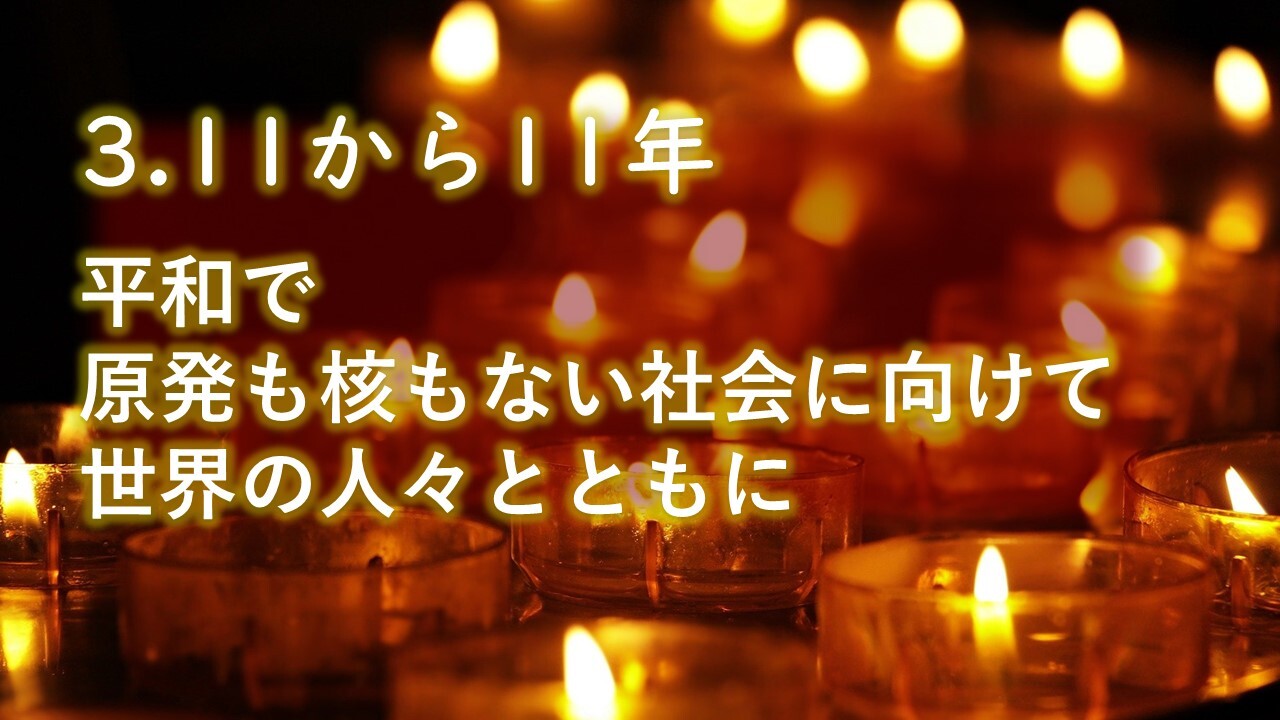
Eleven years have passed since the Great East Japan Earthquake and the disaster at TEPCO’s Fukushima Daiichi Nuclear Power Plant.
Nuclear power plants that had been deemed “completely safe” by the government and power companies, exploded one after another. Radioactive materials that were supposedly confined behind “five-layered walls” leaked out into the sea and onto land, causing long-term radioactive contamination.
What must not be forgotten is that society as a whole took the mass production and consumption of electricity for granted, and had subconsciously accepted the propaganda of the government and power companies that justified the use of nuclear power plants. The fact that the electricity generated at the power plant in Fukushima was used, not in Fukushima but in the Tokyo Metropolitan Area, and that many workers were forced to suffer radiation exposure in order to operate the plant, were injustices that had not been recognized by many. This structural injustice continues to this day.
The nuclear disaster was not supposed to happen. Thus, there was no legal system for victim relief and no robust regulation of radioactive materials in the environment. In 2011, when the government set a standard for evacuation that was 20 times higher than the exposure limit applicable to the general public, many people struggled with the question of whether to evacuate, or to remain. Many were forced to evacuate without compensation or support.
The nuclear disaster is not over. At least 30,000 people are still living as evacuees. However, public assistance, including the provision of housing, has already been cut off, leaving behind some evacuees who cannot afford to pay rent.
Even though evacuation orders have been lifted one after another and support for evacuees has been discontinued, many people have not returned to their homes. Younger generations have not returned, and one- or two-person households of elderly people are living scattered in different areas.
Meanwhile, radioactive materials are being spread by human activities once again. The government has decided on a policy of reusing contaminated soil and radioactive waste generated by decontamination, rather than taking the path of safe storage. Furthermore, the dumping of large quantities of treated contaminated water into the ocean is also causing the spread of radioactive materials. Not only does this water contain tritium, but also strontium-90, iodine-129, and other radioactive materials. TEPCO has stated that it will conduct secondary treatment, but information on the amount and type of radioactive materials that will ultimately remain in the water has not been disclosed.
Under the guise of “preventing damaging rumors,” the government continues to spend vast amounts of national taxpayer money on propaganda to convince the public that radioactive materials are not dangerous. However, the spread of radioactive materials is substantial “damage.” The term “damaging rumor” obscures the responsibility of the actual perpetrators, the government and TEPCO, and makes those who point out the risks of exposure and contamination appear as though they also bear responsibility.
After the disaster, all nuclear power plants owned by TEPCO and Tohoku Electric Power Company were shut down, and a “nuclear power plant free” Eastern Japan has existed for the past 11 years. After the shutdown of Kansai Electric Power’s Oi reactors 3 and 4 in September 2013, nuclear power plants across the country were out of operation for close to two years, resulting in a nationwide nuclear power plant free period. Even after operations were restarted, nuclear power plants were shut down one after another due to delays in the construction of anti-terrorism facilities, court injunctions against operations, and other issues such as cracked pipes. The cost of construction and safety measures for nuclear power plants skyrocketed, and nuclear power plants were no longer a “stable” or “inexpensive” power source.
Russia’s military invasion of Ukraine has resulted in many casualties. One after another, Russian troops are attacking and taking control of nuclear power plants in Ukraine. Needless to say, war is the greatest form of environmental destruction and violation of human rights and totally unacceptable. In addition, attacks on nuclear power plants lead to the spread of radioactive materials, endangering the lives and health of many people for a long time. The risk of nuclear power plants becoming targets of attacks was indicated in the past, and unfortunately this nightmare has now become a reality.
We stand with the victims, and in solidarity with people around the world who wish for peace, and we have renewed our determination to move forward to realize a peaceful, nuclear-free world.

